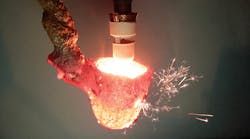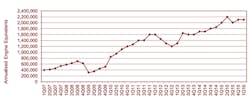CGI process technology developer SinterCast AB reported mixed results in its first-quarter 2016 statement, with mostly stable activity but reduced production levels for some of the casting programs it supplies, resulting in lower quarterly revenues. It listed revenues of SEK16.1 million (est. $1.97 million) for the quarter, down nearly 17% from Q1 2015 (SEK 18.8 million, or est. $2.3 million.)
While most of the group’s licensees continued to produce stable or increased volumes of compacted graphite iron (CG) during the January-March 2016 period, SinterCast stated that some reported reductions that have resulted in an increase of just 5% in year-on-year series production.
It did not identify the foundries that reduced their CGI output.
Stockholm-based SinterCast is the world’s largest supplier of the control technology used by foundries to produce CGI — a lightweight alternative to gray iron and aluminum used mainly for automotive diesel engines and cylinder blocks, though some gasoline engine designs have been introduced in recent model years. Other applications include industrial power engines parts, ranging from 2 kg to 9 metric tons.
The SinterCast process is under license to 44 foundries and product development centers in 13 countries.
“The main growth contributions were derived from the Ford petrol engine, which was still in the initial production ramp during the first quarter of 2015, and the Nissan 5.0 liter diesel engine, following the recent start of pick-up sales in North America,” according to the Q1 2016 statement.
SinterCast licensees supplying CGI castings for commercial vehicle programs also contributed to the quarterly income, though it said reduced demand in the global industrial power sector resulted in a decrease in year-on-year production for such parts during the quarter.
Revenues from the supply of the specialized sampling cup used in the SinterCast process also decreased during Q1 2016, but the developer advised, “quarter-to-quarter variations in sampling cup shipments are normal and this is regarded solely as an order timing effect.” It forecast continued increases in sampling cup shipments.
The timing of new orders also influences the group’s revenue: as Q1 2015 included several new SinterCast placements (three commitments, two installations), and Q1 2016 recorded no new installations, the year-on-year comparison is unfavorable.
“The current outlook for new installations and installation revenue remains positive, with several ongoing discussions for new installations and production capacity upgrades at existing installations,” according to the earnings summary. Shipment is pending for a SinterCast System 3000 Plus system ordered by the Teksid foundry in Brazil during Q4 2015.










